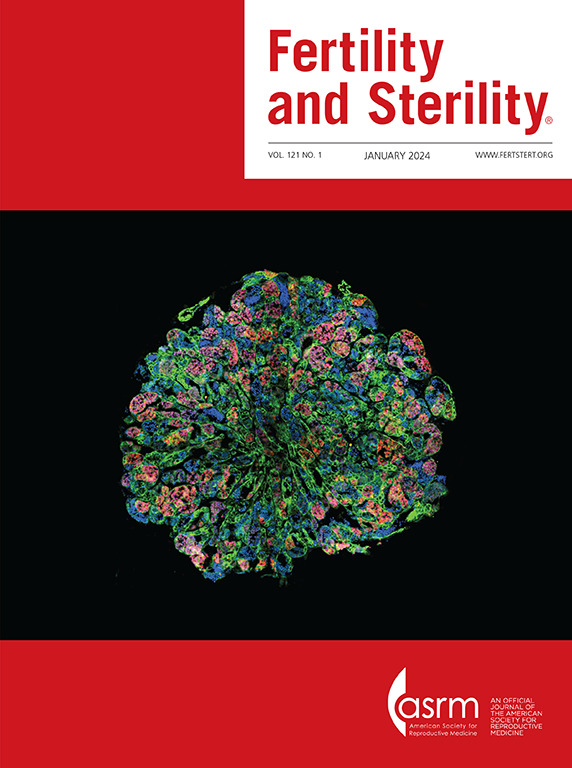玻璃化加热整倍体囊胚移植周期中无透明带对生殖结果的影响。
IF 7
1区 医学
Q1 OBSTETRICS & GYNECOLOGY
引用次数: 0
摘要
目的评价玻璃化加热整倍体囊胚移植周期中透明带缺失对临床、产科和围产期结局的影响。设计回顾性队列研究。这项回顾性研究包括2016年3月至2021年12月在三级学术医疗中心进行的1,024次植入前基因检测-冷冻胚胎移植周期的数据。将玻璃化加热的单整倍体囊胚移植分为完整透明带组(未暴露,n=761)和无透明带组(暴露,n=263)。将无透明带冷冻胚胎移植周期与完整透明带冷冻胚胎移植周期按1:1比例进行倾向评分匹配。主要结局指标:主要结局为活产。次要结局是临床妊娠、流产、产科结局(包括剖宫产和胎龄)以及围产期结局(包括出生体重和出生缺陷)。结果倾向评分匹配前,无透明带组临床妊娠率(51.71% vs. 63.73%, P=0.001)和活产率(44.11% vs. 56.64%, P= 0.05)显著低于匹配后的活产率(45.54% vs. 49.77%, P= 0.05)和剖宫产率(80.41% vs. 74.53%, P=0.001)。多因素分析显示,胚胎发育阶段(第6天vs.第5天:优势比=0.70,P=0.029)和囊胚质量(差vs.好:优势比=0.47,P<0.001)是活产的显著预测因素。此外,产妇年龄(优势比=1.09,P=0.003)和子宫内膜厚度(优势比=0.83,P=0.015)与剖宫产的可能性显著相关。结论透明带的缺失不会独立影响玻璃化加热单整倍体囊胚移植的临床、产科或围产期结局。胚胎选择的标准,特别是发育阶段和质量,是成功妊娠结局的关键决定因素。本文章由计算机程序翻译,如有差异,请以英文原文为准。
Impact of no zona pellucida on reproductive outcomes in vitrified-warmed euploid blastocyst transfer cycles.
OBJECTIVE
To evaluate the impact of the absence of the zona pellucida on clinical, obstetric, and perinatal outcomes in vitrified-warmed euploid blastocyst transfer cycles.
DESIGN
Retrospective cohort study.
SUBJECTS
This retrospective study included data from 1,024 preimplantation genetic testing-frozen embryo transfer cycles, conducted at a tertiary academic medical center between March 2016 and December 2021.
EXPOSURE
Vitrified-warmed single euploid blastocyst transfers were classified into zona pellucida-intact (unexposed; n=761) and zona pellucida-free (exposed; n=263) groups. Frozen embryo transfer cycles in the zona pellucida-free group were matched with those in the zona pellucida-intact group at a 1:1 ratio using propensity score matching.
MAIN OUTCOME MEASURES
The primary outcome was live birth. Secondary outcomes were clinical pregnancy, miscarriage, obstetric outcomes including cesarean delivery and gestational age, as well as perinatal outcomes including birth weight and birth defects.
RESULTS
Before propensity score matching, the zona pellucida-free group exhibited significantly lower rates of clinical pregnancy (51.71% vs. 63.73%, P=0.001) and live birth (44.11% vs. 56.64%, P<0.001), as well as a higher rate of cesarean delivery (81.03% vs. 70.30%, P=0.018). However, these differences were no longer statistically significant (clinical pregnancy, 53.52% vs. 54.46%, P>0.05; live births, 45.54% vs. 49.77%, P>0.05; cesarean delivery, 80.41% vs. 74.53%, P>0.05) after matching. Multivariate analysis revealed that the embryo development stage (day 6 vs. day 5: odds ratio=0.70, P=0.029) and blastocyst quality (poor vs. good: odds ratio=0.47, P<0.001) were significant predictors of live birth. Furthermore, maternal age (odds ratio=1.09, P=0.003) and endometrial thickness (odds ratio=0.83, P=0.015) were significantly associated with the likelihood of a cesarean delivery.
CONCLUSION
The absence of the zona pellucida did not independently affect clinical, obstetric, or perinatal outcomes in vitrified-warmed single euploid blastocyst transfers. Criteria for embryo selection, particularly developmental stage and quality, were critical determinants of successful pregnancy outcomes.
求助全文
通过发布文献求助,成功后即可免费获取论文全文。
去求助
来源期刊

Fertility and sterility
医学-妇产科学
CiteScore
11.30
自引率
6.00%
发文量
1446
审稿时长
31 days
期刊介绍:
Fertility and Sterility® is an international journal for obstetricians, gynecologists, reproductive endocrinologists, urologists, basic scientists and others who treat and investigate problems of infertility and human reproductive disorders. The journal publishes juried original scientific articles in clinical and laboratory research relevant to reproductive endocrinology, urology, andrology, physiology, immunology, genetics, contraception, and menopause. Fertility and Sterility® encourages and supports meaningful basic and clinical research, and facilitates and promotes excellence in professional education, in the field of reproductive medicine.
 求助内容:
求助内容: 应助结果提醒方式:
应助结果提醒方式:


